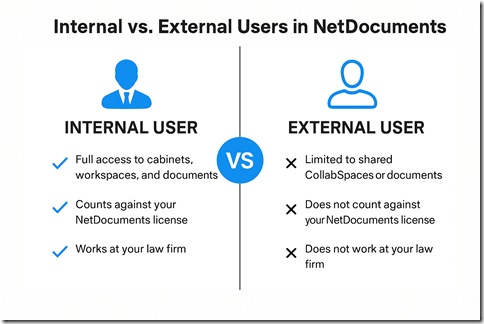When configuring NetDocuments for your law firm, one of the most important decisions you’ll face is whether to classify a user as Internal or External. This designation impacts everything from document access and collaboration capabilities to licensing costs and security settings. Understanding the differences—and knowing when to use each—is crucial for building a secure and efficient document management system.
What Is an Internal User?
An Internal User is someone who works at your law firm and requires full access to your NetDocuments environment. This includes attorneys, paralegals, legal assistants, and administrative staff.
Key Characteristics:
- Full access to cabinets, workspaces, and documents (based on permissions).
- Counts toward your NetDocuments license total.
- Can use NetDocuments Office integrations (e.g., Outlook, Word).
Typical Use Case: Internal Users are ideal for team members who need daily access to documents, collaboration tools, and firm-wide resources.
What Is an External User?
An External User is someone outside your organization—such as clients, co-counsel, or expert witnesses—who needs limited access to specific documents or folders.
Key Characteristics:
- Access is restricted to a few matters or CollabSpaces.
- Does not count against your NetDocuments license.
- Cannot access full cabinets or workspaces.
- Cannot use NetDocuments Office integrations. (Because they don’t have access to the profile attributes)
- Typically used for secure, read-only collaboration.
Typical Use Case: External Users are best for short-term or limited access scenarios, such as sharing documents with clients or collaborating with outside counsel on a specific matter.
How to Decide: Internal vs. External?
Ask yourself the following questions:
- Is the user part of your firm’s daily operations? → Internal
- Do they need access to multiple matters or workspaces? → Internal
- Are they a client or third party needing access to a few documents? → External
- Do you want to avoid using a paid license for this user? → External
When to Make an External User an Internal User
There are cases where it makes sense to treat someone outside your firm—like co-counsel—as an Internal User. For example, if the co-counsel is working on multiple matters (10+) and needs full access to documents, workspaces, and NetDocuments Office integrations, it’s often more practical to set them up as an Internal User.
This allows them to work seamlessly within your NetDocuments environment, just like your internal staff. However, this approach comes with a cost: Internal Users require paid licenses, while External Users do not.
Why Profile Attributes Matter
NetDocuments uses profile attributes like Client and Matter to organize documents. By default, these lookup tables are hidden from External Users. So if an External User is granted access to a few CollabSpaces, they can only see the specific matters shared with them—not your entire client list.
If you want a co-counsel (as an External User) to see these profile attributes across multiple matters, NetDocuments requires a global configuration change that makes these tables visible to all External Users. This is rarely advisable, especially if you have multiple external collaborators with varying access needs.
Final Thoughts
Choosing between Internal and External User roles in NetDocuments isn’t just a technical decision—it’s a strategic one. It affects how your firm collaborates, secures data, and manages costs. If you’re unsure which setup is best for a particular user, consider their access needs, the duration of their involvement, and whether they require full integration with your document workflows.



